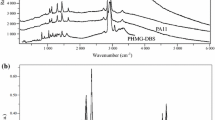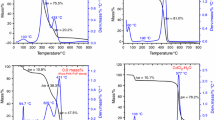Abstract
A series of blends of dodecylbenzenesulfonic acid (DBSA)-doped polyaniline (PANDR) and PVC were synthesized by solution blending technique and investigated by heatflow microcalorimetry (HFC) for thermal and oxidative stability and for PVC–PANDR compatibility. FTIR results provided evidence for strong dipole–dipole interactions between PANDR and PVC. The energy of the oxidation is independent of the composition. The interaction energy and thermal stability increased with the increase of PANDR content in the blend. The activation energies calculated by using Arrhenius relationship can be employed for accelerated ageing of the synthesized blends. It has been observed that the average degradation of PANDR component is higher than that of PVC.













Similar content being viewed by others
References
Pielichowski K. Thermal degradation of poly(vinyl chloride)/polyaniline conducting blends. J Therm Anal Calorim. 1998;54:171–5.
Gul VE. Structure and properties of conducting polymer composites. Utrecht, The Netherlands: VSP; 1996.
Shipway AN, Willner I. Nanoparticles as structural and functional units in surface-confined architectures. Chem Commun. 2001;2035–45.
Tsocheva D, Tsanov T, Terlemezyan L. Ageing of conductive Polyaniline/poly(ethylene-co-vinylacetate) composites studied by thermal methods. J Therm Anal Calorim. 2002;68:159–68.
Cao Y, Smith P, Heeger AJ. Counter-ion induced processability of conducting polyaniline and of conducting polyblends of polyaniline in bulk polymers. Synth Met. 1992;48:91–7.
Al-Ahmed A, Mohammad F, Rahman MZA. Composites of polyaniline and cellulose acetate: preparation, characterization, thermo-oxidative degradation and stability in terms of DC electrical conductivity retention. Synth Met. 2004;144:29–49.
De Farias RF, Nunes LM. Thermogravimetric study about PVC-polyaniline blends. J Therm Anal Calorim. 2002;70:559–64.
Lin FY, Chen WY, Hearn M. Microcalorimetric studies on the interaction mechanism between proteins and hydrophobic solid surfaces in hydrophobic interaction chromatography: effects of salt, hydrophobicity of the sorbent, and structure of the protein. Anal Chem. 2001;73:3875–83.
Forsstrom D, Svensson LG, Terselius B. Thermo-oxidative stability of polyamide 6 films III. Isothermal microcalorimetry. Polym Deg Stab. 2000;67:263–9.
Forsstrom D, Hamskog M, Eriksson P, Terselius B. Oxidation of unstabilised polypropylene particles as studied by microcalorimetry and chemiluminescence techniques. Polym Deg Stab. 2003;81:81–8.
MacDiarmid AG, Chiang JC, Richter AF, Somasiri NLD, Epstein AJ. Polyaniline: Synthesis and characterization of the emeraldine oxidation state by elemental analysis. In: Alcacer L, editor. Conducting polymers. Dordrecht: Reidel Publishing Co; 1987. p. 105–20.
Cao Y, Smith P, Heeger AJ. Counter-ion induced processibility of conducting polyaniline. Synth Met. 1993;57:3514–9.
Suurkuusk J, Wadso I. A multichannel microcalorimetry system. Chem Scr. 1982;20:155–63.
Afzal AB, Akhtar MJ, Nadeem M, Ahmed M, Hassan MM, Yasin T, Mehmood M. Structural and electrical properties of polyaniline/silver nanocomposites. J Phys D Appl Phys. 2009;42:015411 (8 pp).
Afzal AB, Akhtar MJ, Nadeem M, Hassan MM. Investigation of structural and electrical properties of polyaniline/gold nanocomposites. J Phys Chem C. 2009;113:17560–5.
Afzal AB, Akhtar MJ, Nadeem M, Hassan MM. Dielectric and impedance studies of DBSA doped polyaniline/PVC composites. Curr Appl Phys 2010;10:601–6.
Ameen S, Ali V, Zulfequar M, Haq MM, Husain M. Electrical and spectroscopic characterization of polyaniline-polyvinyl chloride (PANI-PVC) blends doped with sodium thiosulphate. Physica B Condens Matter. 2008;403:2861–6.
Cui B, Qiu H, Fang K, Fang C. Effect of vacuum annealing on characteristics of the DBSA-doped polyaniline pellets. Synth Met. 2007;157:11–6.
Beltran M, Marcilla A. Fourier transform infrared spectroscopy applied to the study of PVC decomposition. Eur Polym J. 1997;33:1135–42.
Pan W, Yang SL, Li G, Jiang JM. Electrical and structural analysis of conductive polyaniline/polyacrylonitrile composites. Eur Polym J. 2005;41:2127–33.
Pielichowski K, Janowski B. Semi-interpenetrating polymer networks of polyurethane and poly(vinyl chloride). J Therm Anal Calorim. 2005;80:147–51.
Rannou P, Nechtschein M, Travers JP, Berner D, Wolter A, Djurado D. Ageing of PANI: chemical, structural and transport consequences. Synth Met. 1999;101:734–7.
Neoh KG, Kang ET, Tan KL. Thermal degradation of leucoemeraldine, emeraldine base and their complexes. Thermochim Acta 1990;171:279–91.
Svensson LG. Using isothermal microcalorimetry for the prediction and testing of long-term properties of materials and products. J Therm Anal Calorim. 1997;49:1017–23.
Elmqvist CJ, Lagerkvist PE, Svensson LG. Stability and compatibility testing using a microcalorimetric method. J Hazard Mater. 1983;7:281–90.
Svensson LG, Taylor DE, Forsgren CK, Backman PO. Microcalorimetry and impact testing applied to the study of explosive/polymer compatibility. In: Proceedings of ADPA symposium on compatibility of plastics and other materials with explos propell pyrot. Long Beach, California, USA; 1986, p. 86–91.
Acknowledgements
We are grateful to Higher Education Commission (HEC) of Pakistan for the financial support through indigenous scholarship scheme for Ph. D. studies of Asma Binat Afzal in science and technology (Batch II). We are thankful to Dr. Dan Forsström for his help in the experiment and useful discussions.
Author information
Authors and Affiliations
Corresponding author
Rights and permissions
About this article
Cite this article
Afzal, A.B., Akhtar, M.J. & Svensson, LG. Thermal studies of DBSA-doped polyaniline/PVC blends by isothermal microcalorimetry. J Therm Anal Calorim 100, 1017–1025 (2010). https://doi.org/10.1007/s10973-009-0615-1
Received:
Accepted:
Published:
Issue Date:
DOI: https://doi.org/10.1007/s10973-009-0615-1




